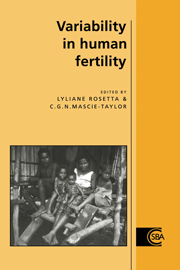Book contents
- Frontmatter
- Contents
- List of contributors
- 1 Introduction: the biological anthropological approach
- PART I HORMONAL ASPECTS OF FERTILITY REGULATION
- PART II INTERPOPULATION VARIABILITY
- 5 Age and developmental effects on human ovarian function
- 6 Non-pathological source of variability infertility: between/within subjects and between populations
- 7 The relationship between disease and subfecundity
- PART III METABOLIC AND ENERGETIC ASPECTS OF REGULATION
- Index
5 - Age and developmental effects on human ovarian function
Published online by Cambridge University Press: 03 February 2010
- Frontmatter
- Contents
- List of contributors
- 1 Introduction: the biological anthropological approach
- PART I HORMONAL ASPECTS OF FERTILITY REGULATION
- PART II INTERPOPULATION VARIABILITY
- 5 Age and developmental effects on human ovarian function
- 6 Non-pathological source of variability infertility: between/within subjects and between populations
- 7 The relationship between disease and subfecundity
- PART III METABOLIC AND ENERGETIC ASPECTS OF REGULATION
- Index
Summary
Ever since Malthus assigned fertility regulation to the realm of social behaviour and ‘ moral restraint ’, there appears to have been a reluctance on the part of demographers to view normal (i.e. non-pathological) biological factors as presenting anything more than some upper limit on human fecundity. Menarche, menopause, the fixed duration of gestation, perhaps some unavoidable frequency of pregnancy loss, these are often viewed as providing a set of bounds on the human potential for offspring production (Bongaarts & Potter, 1983; Campbell & Wood, 1988). But an understanding of variation within these bounds is ordinarily sought in terms of human behaviour; rates of marriage and divorce, the use of contraception and abortion, the frequency of intercourse and spousal separations, lactation and weaning. There is no question that these aspects of our social and personal behaviour strongly influence our fertility, nor that they themselves are shaped by more distal elements of our cultural values and social and economic institutions. At the same time it is becoming increasingly apparent that biologically and ecologically mediated variation in female fecundity also contributes to patterns of human fertility. Age effects on female fecundity provide a particularly clear example both of the importance of biological factors affecting fertility, and of the potential for biological anthropologists to contribute empirically and theoretically to our understanding of human fertility variation.
Age and natural fertility
The age pattern of female fertility is one of the most familiar aspects of human demography and one of the basic elements in our understanding of human population dynamics.
- Type
- Chapter
- Information
- Variability in Human Fertility , pp. 69 - 90Publisher: Cambridge University PressPrint publication year: 1996
- 8
- Cited by

